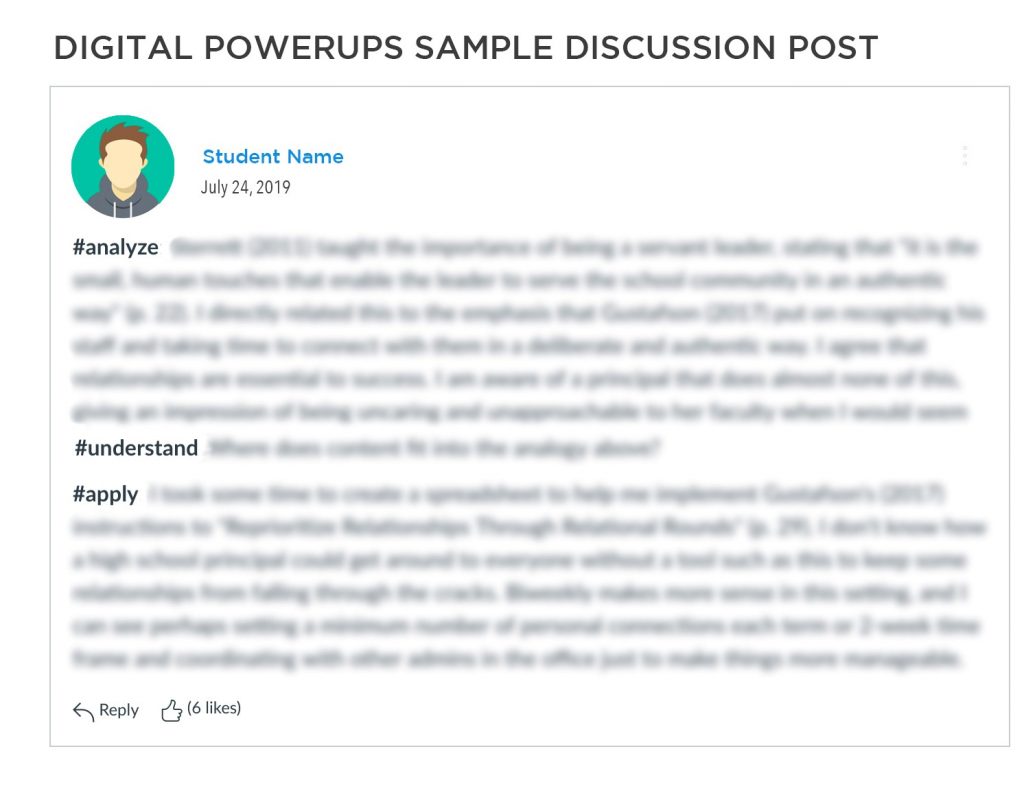
Description
The digital powerups strategy provides an innovative way for instructors to engage students in higher-order online discussion by humanizing and personalizing the discussion. This strategy should be used to allow students to engage in online discussions in relevant and authentic ways. Online discussions can “allow students to participate actively and interact with students and faculty” (Baglione & Nastanski, 2007, p. 139); however, without proper course design and teacher presence online discussions tend to only focus on “lower level of thinking and discourse” (Christopher, Thomas, & Tallent-Runnels, 2004, p. 170). Pushing students into higher-order thinking can be challenging and requires the instructor to provide appropriate scaffolding (Kanuka, Rourke, & Laflamme, 2007; Whitely, 2014). However, when students use Bloom’s taxonomy as a scaffold to engage in higher-level discourse in online discussions, students are found to reach higher levels of cognitive processing, engage in metacognition, and become more involved in the classroom learning community (Valcke, De Wever, Zhu, & Deed). Structuring online discussions with Bloom’s is one way to scaffold student participation and support students engaging in both social presence and cognitive presence aspects of discourse (deNoyelles, Zydney, & Chen, 2014). Further, using Bloom’s to engage students in higher-order discourse is “an innovative and creative way to nurture student learning” (Liu & Yang, 2012, p. 479). Enter digital powerups.
Simply stated, digital powerups are keywords displayed as hashtags that are associated with corresponding prompts in online discussions. The digital powerups strategy is theoretically grounded in the dynamic interplay between social presence and cognitive presence in the Community of Inquiry (CoI) framework. At it’s core, CoI “is social constructivist in nature and is concerned with deep and meaningful learning” (Joksimović, Gašević, Kovanović, Riecke, & Hatala, 2015, p. 640) which must be centered in a learning environment that encourages discourse and community building as a means of engaging students in an educational experience (Garrison, Cleveland-Innes, & Fung, 2010). Specifically, the digital powerups strategy was designed to empower students with both choice and voice which is an effective way to engage students in course activities (Lee, Pate, & Cozart, 2015; Reeve & Jang, 2006).
Link to example artifact(s)
Instructor: Travis N. Thurston, Assistant Director of Empowering Teaching Excellence, Academic ; Instructional Services, Utah State University
Course Title: TEAL 6280: Instructional Leadership – Instructional Practices for Diverse Learners

In this fully online graduate level course the digital powerups strategy was incorporated into the weekly online discussions. Each week students were given a set of readings to engage with beforehand, and then rather than being given a specific question to address, students were rather provided with a prompt to allow them to engage from different entry points (Riggs & Linder, 2016).
For each discussion forum, students were instructed that their initial post should include 2-3 powerups and their comments to peers should include 1-2 powerups as well. In other words, students were giving the option to address the weekly prompt using 2-3 of the available digital powerups.
Students were further instructed that utilizing the digital powerups not only helps to structure the responses, but they will frame ways to engage in meaningful discourse allowing them to learn from one another. It is important with this strategy to be very explicit in the instructions and the intentionality behind their use. Students were further instructed that typically it takes at least 2 or 3 sentences to properly address each of the powerups selected (or a 2-3 minute video recording). Students were also required to identify/code/tag their responses by using the appropriate hashtag that corresponds to the digital powerups that they were addressing (EX. #understand How can using digital powerups enrich online discussions?). A list of digital powerups was provided in a tab along with instructions on each weekly discussion forum.
Digital Powerups for Online Discussions: Sample Key
Conference Presentation Excerpt on the Use of Digital Powerups
Link to scholarly reference(s)
Baglione, S., & Nastanski, M. (2007). The superiority of online discussions: Faculty perceptions. The Quarterly Review of Distance Education, 8(2), 139-150.
deNoyelles, A., Zydney, J. M., & Chen, B. (2014). Strategies for creating a community of inquiry through online asynchronous discussions. Journal of Online Learning and Teaching, 10(1), 153-165.
Garrison, D. R., Cleveland-Innes, M., & Fung, T. S. (2010). Exploring causal relationships among teaching, cognitive and social presence: Student perceptions of the community of inquiry framework. The Internet and Higher Education, 13(1-2), 31-36.
Gustafson, B. (2016). Renegade leadership: Creating innovative schools for digital-age students. Corwin Press.
Jang, H., Reeve, J., & Deci, E. L. (2010). Engaging students in learning activities: It is not autonomy support or structure but autonomy support and structure. Journal of Educational Psychology, 102(3), 588.
Joksimović, S., Gašević, D., Kovanović, V., Riecke, B. E., & Hatala, M. (2015). Social presence in online discussions as a process predictor of academic performance. Journal of Computer Assisted Learning, 31(6), 638-654.
Kanuka, H., Rourke, L., & Laflamme, E. (2007). The influence of instructional methods on the quality of online discussion. British Journal of Educational Technology, 38(2), 260-271.
Krathwohl, D. R. (2002). A revision of Bloom’s taxonomy: An overview. Theory into Practice, 41(4), 212-218.
Lee, E., Pate, J. A., & Cozart, D. (2015). Autonomy support for online students. TechTrends, 59(4), 54-61.
Liu, C. J., & Yang, S. C. (2012). Applying the practical inquiry model to investigate the quality of students’ online discourse in an information ethics course based on Bloom’s teaching goal and Bird’s 3C model. Computers & Education, 59(2), 466-480.
Riggs, S., & Linder, K. (2016). IDEA Paper: Actively engaging students in asynchronous online classes. Manhattan, KS: The IDEA Center.
Valcke, M., De Wever, B., Zhu, C., & Deed, C. (2009). Supporting active cognitive processing in collaborative groups: The potential of Bloom’s taxonomy as a labeling tool. The Internet and Higher Education, 12(3), 165-172.
Whiteley, T. R. (2014). Using The Socratic Method and Bloom’s Taxonomy of the Cognitive Domain to Enhance Online Discussion, Critical Thinking, and Student Learning. Developments in Business Simulation and Experiential Learning, 33.
Citations
Thurston, T. (2020). Digital #powerups: hashtags to empower higher-order student engagement in online discussions. In A. deNoyelles, A. Albrecht, S. Bauer, & S. Wyatt (Eds.), Teaching Online Pedagogical Repository. Orlando, FL: University of Central Florida Center for Distributed Learning. https://topr.online.ucf.edu/digital-powerups-hashtags-to-empower-higher-order-student-engagement-in-online-discussions/.